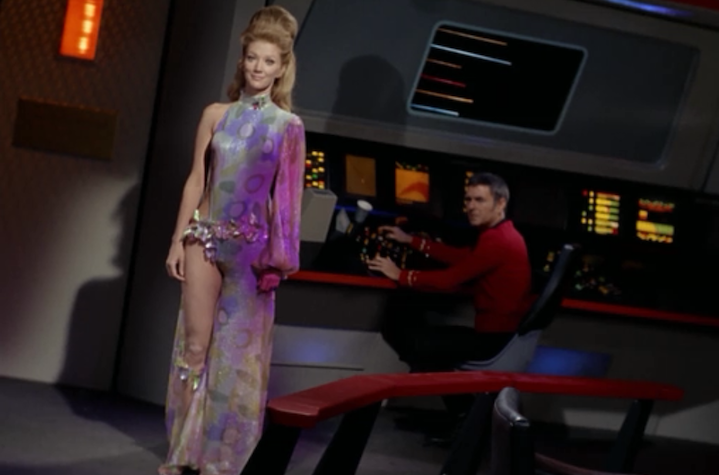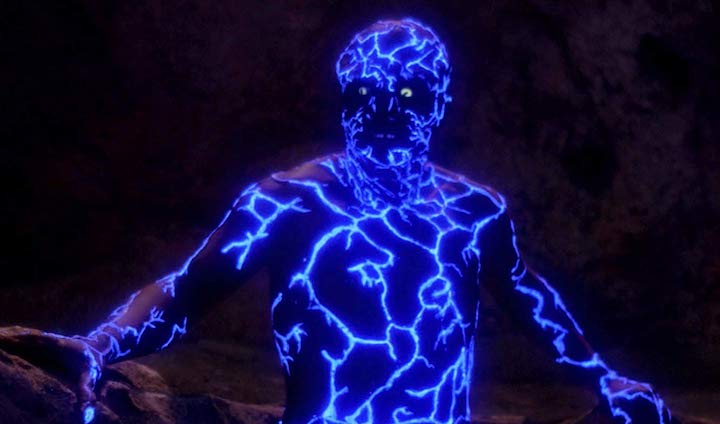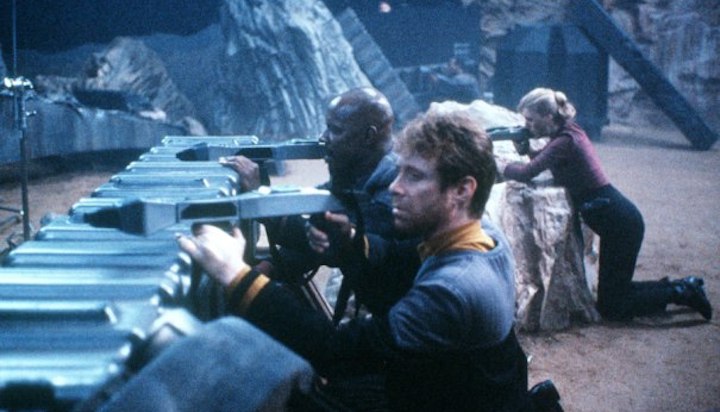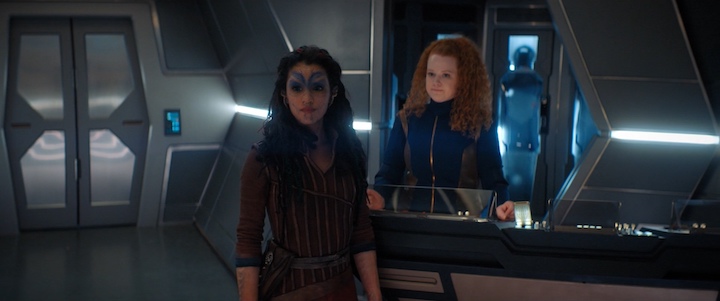With the US release of Blumhouse’s THE INVISIBLE MAN this week, we’re going to take a look at films with characters that are hard to see. For this is…

Science fiction and horror have used invisibility as a plot device since H.G. Wells’ The Invisible Man in 1897. Like many kids, I dreamt of being invisible, but, alas, it was not meant to be—no purloined cookies from the cookie jar. Star Trek, in its many TV incarnations, has used various tried-and-trued science fiction tropes and invisibility has been used occasionally. Here are a few select episodes that deal with invisibility in its many “guises”—like each series, there are good, bad, and perplexing episodes, but even bad Star Trek is entertaining, at least to me.
“Balance of Terror” (Star Trek—Season 1, Episode 14)
In this classic Star Trek episode, the Enterprise responds to a distress call from outposts along the Federation-Romulan Neutral Zone under attack by a mysterious ship, encountering the Romulans for the first time in nearly a century. The added problem: the Romulan ship has a device rendering it invisible to the starship’s sensors! It’s considered one of the best episodes of the ’60s series and it’s not hard to see why: the cat-and-mouse game played by Captain Kirk (William Shatner) and his Romulan counterpart (Mark Lenard, a year away from his recurring role of portraying Sarek, Spock’s father) is a thrilling allusion to WWII submarine warfare (and especially the 1958 film RUN SILENT, RUN DEEP). Lenard’s Romulan Commander is a noble character, a soldier weary of battle and expansion, but not so much of a maverick to defy orders.
This episode has it all: a potential shipboard wedding presided by Kirk, which ends in tragedy (shipboard romances are doomed frequently), space battle, and a lot of tension. There’s an exceptional quiet moment between Kirk and Dr. McCoy, as Kirk expresses his doubts about their mission privately in his quarters. There’s also a bigot on the bridge, Lt. Styles, who’s convinced Spock is a Romulan spy, as it’s revealed that Vulcans and Romulans are related because they look so much alike (it’s those pointy ears!). It’s a satisfying commentary on prejudice early in the series, as Star Trek would continue to explore social issues in the guise of science fiction during its brief three-year run (Writer/Story Editor Dorothy Fontana would coin the term “cloaking device” in another Romulan-themed episode in Season 3, “The Enterprise Incident,” giving future sci-fi writers a name to the technology they’d exploit narratively).

“Wink of an Eye” (Star Trek—Season 3, Episode 11)
The inhabitants of the planet Scalos are invisible to the Enterprise crew because they move faster than the naked eye can detect–only an insect-like buzzing is heard. The way to gain this invisibility/super-speed is drinking Scalosian water, which happens to Kirk, courtesy of the Scalosian leader, Deela (Kathie Browne). sneaking some into his Starfleet-issued coffee. The Scalosians are trapped in an accelerated state and cannot procreate, so they want to put the Enterprise men in stasis to use them in lieu of the few remaining sterile Scalosian men (what about the women?). Like many of the third-season episodes, “Wink of an Eye” is a silly-but-entertaining episode—its narrative logic doesn’t make sense and the science is suspect, but I watch Trek for its characters and stories, not science. It’s also an episode that contributes to Kirk’s (undeserved) reputation as a galactic Lothario. The viewer even sees Kirk putting his boots back on while Deela brushes her hair, post-coitus, in Kirk’s quarters—scandalous for the late ’60s!

“Identity Crisis” (Star Trek: The Next Generation—Season 4, Episode 18)
Poor Geordi. The writers never gave him a break, whether it was his futility with women (he fell in love with a holodeck recreation of one of the Enterprise’s designers during a crisis and his friends made sure he never forgot) or playing sidekick Watson to Data’s Holmes. In this episode, Geordi (LeVar Burton) learns he contracted a retro-active virus years ago that’s changing his DNA, so much so that he’s becoming an invisible blue-veined alien, detectable only by a device Data constructs (yes, I do realize how ridiculous these plot descriptions are). It’s written by future Enterprise co-creator Brannon Braga, a genre fan who wrote some weird horror-centric Star Trek episodes. I think the execution is too clumsy to give it a hearty recommendation, but it’s weirder than the typical TNG episode.
“Scientific Method” (Star Trek: Voyager—Season 4, Episode 7)
Speaking of Brannon Braga, when TNG ended, he moved to Voyager and became its showrunner, adding not only a former Borg drone Seven of Nine (Jeri Ryan), but terrorizing the stalwart Voyager crew with his distinctive cosmic horror. When crewmembers complain of mysterious maladies (including Captain Janeway’s persistent headache), the Doctor (Robert Picardo), the ship’s EMH (Emergency Medical Hologram), struggles to find the cause. He and Seven discover it’s the handiwork of aliens who cloak themselves in order to infect the crew and record the results. They confront the aliens who claim they’re doing research to benefit the entire Delta Quadrant, ethics be damned.
Janeway (Kate Mulgrew) takes, ah, very drastic measures to get them off her ship (that’s why she’s a great captain). It’s a fun twist on the invisibility angle and the episode is filled with creepy moments, such as Seven seeing the cloaked aliens stick needles into an unsuspecting Janeway, but unable to react, so as not to give herself away. I appreciate a good debate on ethics and Janeway and the head alien researcher deliver, as Janeway still grapples with her decision to adhere to Starfleet principles which resulted in stranding her crew 70 000 light years from home.

“The Siege of AR-558” (Star Trek: Deep Space Nine—Season 7, Episode 8)
I consider Deep Space Nine to be the best-written Star Trek, as it wasn’t as sunny as TNG, its mix of Starfleet and Bajoran personnel (and one loveably-conniving Ferengi bartender) creating much-needed conflict absent on its sister series. It introduced serial storytelling to the Trek mythos, something that’s commonplace on TV today, but was still novel in the ’90s. For most of the series’ run, the Federation and its allies are engaged in conflict and, subsequently, a full-out war with The Dominion—an anti-Federation group from the other side of Bajor’s stable wormhole. By the seventh and final season, the war was taking its toll on both sides, particularly Captain Sisko (Avery Brooks) and his crew.
In this episode, they struggle with two separate invisibility issues: they arrive to a captured Dominion listening outpost, a key tactical advantage, but the outpost is protected by only a handful of Starfleet soldiers and is filled with mines cloaked in subspace, which change locations frequently, resulting in numerous deaths. Sisko’s landing party and the weary soldiers (who haven’t been replaced since they captured the outpost) are also outnumbered by nearby Dominion soldiers, the Jem’Hadar (an alien race bred specifically for battle by the Dominion) who use personal cloaking devices to remain hidden from their sensors.
The Starfleet group must work together to stop the invisible mines and the Jem’Hadar soldiers’ imminent attack. This is a very dark episode, highlighting the horrors of war without resorting to cliché—the stakes are high and there isn’t a tidy resolution. The few remaining Starfleet soldiers are far from the idealistic, principled people we’ve come to expect—they’re tired, frightened, and have lost hope. It’s Quark (Armin Shimerman), the Ferengi bartender who points out to his nephew, Nog (the first Ferengi in Starfleet), that even humans can turn nasty:
“Let me tell you something about humans, nephew. They’re a wonderful, friendly people—as long as their bellies are full and their holo-suites are working. But take away their creature comforts…deprive them of food, sleep, sonic showers…put their lives in jeopardy over an extended period of time…and those same friendly, intelligent, wonderful people will become as nasty and violent as the most bloodthirsty Klingon. You don’t believe me? Look at those faces, look at their eyes…”
The entire Starfleet group face overwhelming odds within and without, with repercussions that will continue for the rest of the series; unlike TNG, there is no tidy resolution by the end of the episode.

“Runaway” (Star Trek: Short Treks—Season 1, Episode 1)
The new streaming Star Trek shows—particularly Discovery—are divisive, as many crusty, old Trekkies insist the new shows should look as antiquated as the beloved ’60s original, but if we can accept different actors playing the same role, why not imagine the original Enterprise as a state-of-the-art ship of exploration? In between seasons of Discovery, a series of shorts were released, beginning with “Runaway”, in which the Discovery’s socially-awkward Cadet Tilly (Meg Wiseman), off-duty in the ship’s mess hall, encountering a very surprising and invisible stowaway, a planetary princess! It’s a sweet and humorous short, adding nuances to my favourite Discovery character (Tilly’s, ah, spastic personality is hotly debated by fans), as she bonds with the princess, Me Hani Ika Hali Ka Po (Yadira Guevara-Prip), the young leader of the planet Xahea over their parents and the discovery of earth desserts. In 15 minutes, the short exemplifies the qualities that have made Star Trek beloved for over 50 years, encountering new civilizations and making new friends, even in clumsy fashion (attentive viewers will be rewarded, as the short introduces plot elements that would be critical in Discovery’s second-season finale).

With over 750 episodes spread across 8 separate TV series (with more to come), there are many other tales that delight in using pseudo-science to explain invisibility. As 21st Century science continues to use Star Trek as an aspirational tool, I have no doubt I will see practical applications of invisibility in my lifetime, realizing Wells’ classic tale.
Tags: Armin Shimerman, Avery Brooks, Deep Space Nine, Discovery, Gene Roddenberry, Jeri Ryan, Kate Mulgrew, Kathie Browne, LeVar Burton, Mark Lenard, Meg Wiseman, Robert Picardo, Short Treks, star trek, Star Trek: Deep Space Nine, Star Trek: Discovery, Star Trek: The Next Generation, Star Trek: Voyager, The Next Generation, Voyager, William Shatner, Yadira Guevara-Prip


No Comments